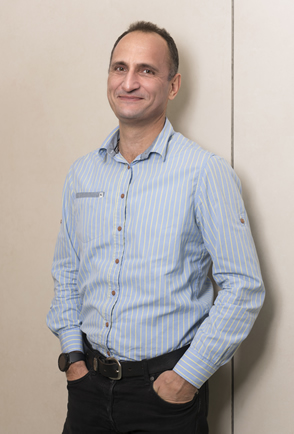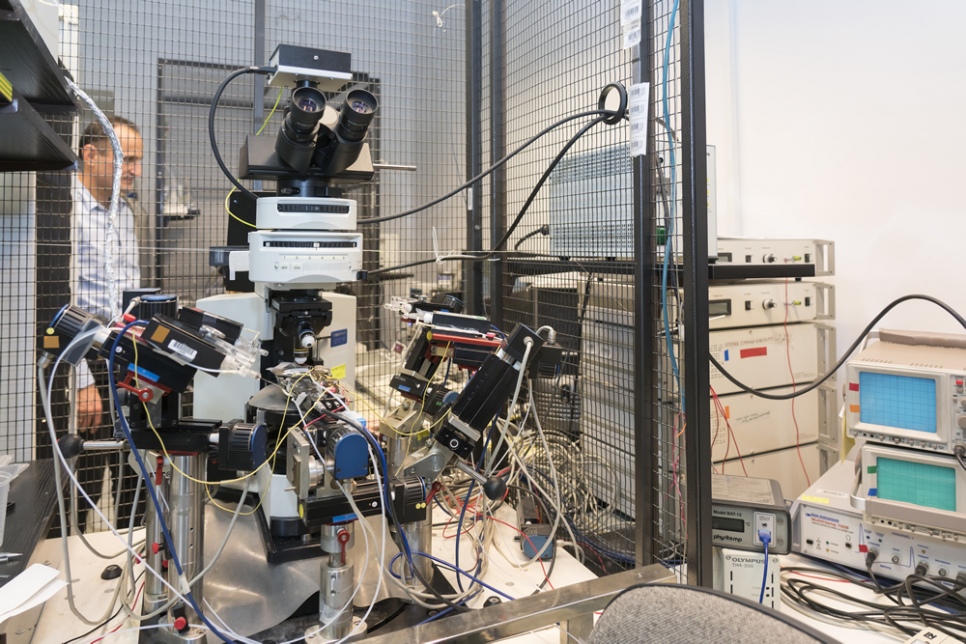
Zoltán Nusser, Széchenyi and Bolyai Prize winning neurobiologist and member of the Hungarian Academy of Sciences (HAS)
Beyond great geographic discoveries, “mapping of our world” is still on the agenda: sophisticated maps are created from the skies and the maps of our nervous system is being created.
Nerve cells or neurons are interconnected in highly complex networks. The examination of these networks started more than a hundred years ago. In the last decade, neuroscientists became interested in revealing the whole connectome of the CNS: connections of every single neuron of the brain.
Our laboratory does not actively participate in mapping neuronal networks, but revealing the molecular makeups, function and structure of the connection points; the synapses. Let me put it this way: when neurons “talk” to each other, their volume is not always the same. For example, if there’s a series of messages flowing across the cells, then there are synapses that put the emphasis on the beginning, while others on the end of the series of messages. The dynamic properties of synapses are no longer a novelty. However, we do not know which molecules are responsible for the variability of synaptic properties.
In this project, we attempt to carry out a molecular mapping of synapses after examining their functions and to find those molecular constellations, ‘molecular fingerprints’ that are responsible for achieving these functions.
There may be as many as two thousand molecules involved in the functioning of a single synaptic connection. But I do not think we will need to map all of them, because there are many proteins that are identical in all synapses and only a small number of them (about two hundred) are different in various synapses. I think most key players are already known to us.
Are you going to go through all two hundred molecules?
Almost. We identify the different proteins, in general, by making rabbits, mice and guinea pigs produce immunoglobulins against each of them and then we extract these immunoglobulins, we can visualize every protein with their help. With such “immunolocalization method” we can identify, for example, the location and the quantity of proteins. Unfortunately, currently we do not have antibodies for all the 200 proteins, but we do have against a sufficient number of the key molecules, the function of which – as I mentioned – is more or less known.
It must be much more difficult to count proteins than blades of grass on a meadow.
An important task of the project is to develop a method for doing such quantification. We are working on optimizing an immunolocalization procedure that is used only by a few labs today; and as we are going to examine synapses with the most sensitive method that has ever been used so far, we hope to receive reliable data: thus we will be able to reveal quantities unreachable so far due to the lack of sufficiently sensitive methods.
Mapping molecular constellations will lead to a new level of understanding.
I hope so.
For example, through establishing the quantity of proteins, your hypothesis can be confirmed (or rejected), namely that the functions of synapses between very similar groups of cells are different from each other because there is a different number of molecules involved in the activities of synapses; and the reason for this difference in the number of molecules is that the previous activity history of the neurons. Consequently, the number of molecules in a synapsis is not constant either.
A synapsis may have quite a few molecules whose quantity varies every second or every few seconds or minute. With our method we are unable to follow such fast changes. But we can show the changes occurring after a two-three-day learning period. The analogy is a bit lame but let’s suppose a neuron gets activated by lemon scent while another one by apple scent, and our test animal has never smelled an apple before. Then for three days I make this animal smell apple and check which of its neurons become activated. Then on brain slice preparations I examine this neuron together with another one that is activated by lemon scent. As I did not use lemon scent I know that the lemon-sensitive cell was less active during those three days, while the apple scent stimulated cell was highly active. I use this information when analysing the synapses of cells activated by a lemon and an apple both on functional and molecular level.
Only a small number of laboratories in the world are able to analyse the molecular composition of synapses with as high sensitivity as we do. On the other hand, there are more laboratories using cutting-edge methods to follow neuron activities in a behaving animals and tell if a cell was activated by an apple or a lemon. But I do not know any such laboratory that would be able to follow the activities and then, using another complex method, to establish the quantity of various proteins in the synapses of the very same neuron.
Combining these different approaches is the real strength of our project.
Once the map of connections between neurons is complete, the molecular information could also be attached to each synapse.
When making a project proposal, one would like to show perspectives, but I think I am a fair proposal writer and I did not promise to find the cure for Alzheimer‘s disease or any other devastating disease. My laboratory with those three or four people funded under the Frontline Programme is not a big one. We can work out a procedure to be able to describe the molecular composition of synapses in a small area of a brain (of a mouse) during a certain activity. If we wanted to extend this research to the whole hippocampal network (and hippocampus is still a very small part of the brain), it would take us twenty to thirty years or it would need five or six similar laboratories all working on this research. And only then could the entire brain be mapped. The infrastructure used in discovery research is not really suitable for this. If our procedure proves really important then it may be upscaled to “industrial” size and automated.

Something similar happened to the Human Genome Project.
In that one, the principal element was the discovery of the basic method. Our procedure does not have such a novelty, but we can shed light to interesting phenomena in the operation of the CNS.
Some people enjoy coordinating large projects, but I prefer managing the work of six to eight researchers. Since I run my own laboratory, the funding I won from competitive sources would have allowed me to employ thirty people, but I never had more than ten researchers working in my laboratory. That is enough for me.
Who are your colleagues now?
I have three senior colleagues, all in their forties. The group also includes four postdoctoral researchers of 30-35 years of age and two PhD students who are in the final stage of finishing their thesis. They will continue their work abroad. Our work are also supported by two technicians. So, the size of the lab is around 10 people.
This is an unusual composition of staff: other laboratories have much more TDK (Scientific Students’ Association) and PhD students. Research with them is cheaper compared to that using postdoctoral researchers. This is the reason why our salary costs are high and a major part of the Frontline project budget is spent on the researchers’ salary. Salaries are using up an increasing amount of research costs also in Hungary.
I see an interesting coincidence between ERC and Hungarian grants. The two Momentum grants in Hungary can be matched to ERC‘s Starting and Consolidator Grants. After the second Momentum grant, having worked with at least four to five people for six to eight years, one did not know where to get money from to continue. I really appreciate that the NRDI Office launched the Frontline Programme to meet this challenge.
This grant can be an advantage even in a future Frontline application.
Not necessarily. Maybe next time I will have to submit a project proposal together with young colleagues who have their ERC Consolidator Grants expiring by that time and they are also doing reasearch under ideal circumstances for five years. But it’s okay. What is important is to have qualified experts delivering high-quality work in Hungary whose performance is outstanding also in international comparison and who contest for winning the best grants in open competitions.






